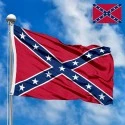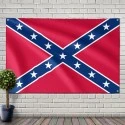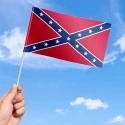- All Flags
- Flags of Countries by Continent
-
Flags of Organizations
- Flags of UN countries
- Flags of the European Union countries
- Flags of NATO countries
- Flags of the countries of the Organization of Islamic Cooperation
- Flags of the countries of the Organization of American States
- Flags of the Arab League countries
- Flags of the African Union countries
- Flags of the countries of the Union of South American Nations
- Flags of the Commonwealth of Nations
- Flags of the countries of the Secretariat of the Pacific Community
- Flags of the Nordic Council countries
- Flags of the Caribbean Community
- Flags of the countries of the Association of Southeast Asian Nations
- Flags of the East African Community
- Flags of the countries of the Organization of Turkic States
- LGBT Community Flags
- Historical Flags
- Ethnic Flags
- Flags of the USA (states)
Description
The Confederate Flag, a symbol with a deeply divisive and complex history, represents the short-lived Confederate States of America (CSA) that existed from 1861 to 1865. Far from being a single, unified banner, the flags of the Confederacy evolved over time, reflecting the challenges and changing identities of a nation forged in a rebellion rooted in the preservation of slavery. The most recognized and controversial of these flags is not an official national standard, but the Confederate Battle Flag, a powerful emblem that continues to provoke intense debate today. For some, it is a symbol of Southern heritage, regional pride, and a romanticized vision of a bygone era. For others, it is an undeniable symbol of slavery, white supremacy, and racial oppression. To understand its significance, one must explore the distinct banners that defined the Confederacy and the lasting legacy they have left behind.
Design and Symbolism: A History in Three National Flags and One Iconic Battle Flag
The Confederacy adopted three official national flags, each with its own design and symbolic purpose. However, the most enduring image is that of a separate, military flag created for the battlefield.
-
First National Flag: The "Stars and Bars" Adopted in March 1861, the first official flag of the CSA, known as the "Stars and Bars," featured a design that was strikingly similar to the U.S. flag. It consisted of three broad, horizontal stripes—a red stripe at the top, a white stripe in the middle, and a red stripe at the bottom. In the upper left canton, a circle of white stars on a blue field represented the number of states that had seceded. Initially, there were seven stars, growing to thirteen as more states joined the Confederacy. The flag's dimensions were typically 1:2. The striking resemblance to the Union's "Stars and Stripes" caused confusion on the battlefield, making it a poor choice for a military standard and leading to calls for a new design.
-
Second National Flag: The "Stainless Banner" Adopted in May 1863, the second national flag was a direct response to the problems of its predecessor. It featured a pure white field with the famous Confederate Battle Flag placed as a canton in the upper left corner. The all-white field, which gave the flag its name, "The Stainless Banner," was chosen to symbolize the "purity of the Southern cause." The dimensions were also 1:2. However, this flag had a major design flaw: when hanging limply, it could easily be mistaken for a flag of truce or surrender, which was a significant issue for a nation at war.
-
Third National Flag: The "Blood-Stained Banner" The final official flag, adopted in March 1865, was a modification of the "Stainless Banner." It added a broad vertical red stripe to the fly (the end of the flag furthest from the pole) to prevent it from being mistaken for a white flag of surrender. This flag, sometimes called "The Blood-Stained Banner," was the official standard for only a month before the Confederacy's collapse, and it is the least known of the three national flags.
-
The Confederate Battle Flag: The Enduring Symbol The most famous flag of the Confederacy is the Confederate Battle Flag. Its design was a result of the battlefield confusion caused by the "Stars and Bars." Designed by General P.G.T. Beauregard, it became the standard for the Army of Northern Virginia. The flag is a square banner with a bold red field and a blue St. Andrew's Cross (a saltire) edged in white. There are 13 white stars on the cross, representing the eleven seceded states and the two border states (Missouri and Kentucky) that had rival Confederate governments. The flag's square shape was chosen to make it stand out from the rectangular national flags. This flag, with its distinct and aggressive design, became the most potent and recognizable symbol of the Confederate cause during the war and remains so today.
History and Origins: A Nation's Flags for a War of Secession
The history of the Confederate flags is intrinsically linked to the American Civil War (1861-1865) and the core principles upon which the Confederacy was founded. The decision by eleven Southern states to secede from the Union was explicitly motivated by the desire to preserve the institution of chattel slavery, a fact repeatedly stated in their secession documents and the speeches of their leaders.
-
The Impetus for Secession: The election of Abraham Lincoln in 1860, on a platform that opposed the expansion of slavery, was the catalyst for secession. South Carolina was the first to leave, followed by ten other states. In February 1861, they formed the Confederate States of America.
-
Creation of the First Flag: The first national flag, the "Stars and Bars," was a quick design created by artist Nicola Marschall. While it was meant to be a symbol of the new nation, its similarity to the Union flag was a major tactical failure on the battlefield, especially in the smoke and chaos of combat.
-
The Birth of the Battle Flag: The need for a new military standard led General Beauregard to commission a new flag. He wanted a design that was clearly distinguishable from the enemy's. The resulting square Battle Flag, with its bold red and blue cross, was immediately popular with soldiers. It became the de facto symbol of the Confederate military and, by extension, the entire Confederacy.
-
Evolution of the National Flags: The failures of the first national flag led to the adoption of the "Stainless Banner." This new flag incorporated the popular Battle Flag into its design. However, its own fatal flaw led to the creation of the final "Blood-Stained Banner" just weeks before the Confederacy's surrender in 1865. The flags' rapid evolution is a testament to the Confederacy's struggles to define a national identity distinct from the Union it had left.
Interesting Facts and the Modern Controversy
The flags of the Confederacy have a fascinating and often contentious history, particularly in the years since the Civil War.
-
Misidentification: The most common mistake is calling the Battle Flag the "Stars and Bars." The "Stars and Bars" was the first national flag. The "Battle Flag" is the diagonal cross design.
-
Post-War Revival: The flags of the Confederacy largely disappeared from public life after the war. However, they were revived in the early to mid-20th century by groups like the Ku Klux Klan and the Dixiecrat Party as symbols of opposition to the Civil Rights Movement. This modern revival cemented the flag’s association with racial segregation and white supremacy, fundamentally altering its public meaning.
-
The Symbol of Southern Heritage: A prominent modern view is that the flag represents a proud Southern heritage, a tribute to the soldiers who fought and died during the Civil War, and a symbol of defiance against federal government overreach. This perspective often separates the flag from the cause of slavery, focusing instead on themes of honor and ancestry.
-
Regional Significance Today: The Confederate Battle Flag is still displayed in many Southern states. It has been a long-standing point of contention, with debates over its display on state buildings, license plates, and public monuments. The flag’s presence in these public spaces is a constant reminder of the deep racial divisions that persist in the United States.
Significance for Inhabitants: A Deeply Divided Symbol
The flags of the Confederacy, particularly the Battle Flag, hold a profoundly different meaning for various groups of people, a division that speaks to the unresolved legacy of the Civil War.
-
For many Southerners, the flag is a tribute to their ancestors who fought and died in the Civil War. It is seen as a symbol of their regional identity, history, and a proud, if tragic, past. They view it as a historical artifact, not a racist emblem, and believe that the flag’s meaning has been unfairly hijacked by hate groups. For them, it represents a defiance of a government they believe overstepped its bounds, a theme that resonates with modern political sentiments.
-
For African Americans and civil rights advocates, the flag is an unequivocal symbol of slavery and racial terror. They see it as a banner of the oppressive system that denied their ancestors their humanity and subjected them to centuries of brutality. The flag's resurgence during the Civil Rights Movement, when it was used by white supremacists to intimidate African Americans, cemented its meaning as a symbol of hatred and a painful reminder of America’s history of racial violence. For them, displaying the flag is a direct attack on their dignity and a celebration of a system built on their oppression.
-
For the country as a whole, the flags of the Confederacy represent an enduring paradox. They are historical artifacts of a painful chapter, yet their modern use turns them into symbols of ongoing political and racial conflict. The flag is a visual representation of America’s unfinished business regarding race, a banner that forces the nation to confront its past and the deep wounds that remain.
In the demonstration images, full-size flags are shown with proportions of 2:3, and hand-held flags with proportions of 1:2.
Donation
Download
Completely free for commercial and non-commercial use (public domain).
You can freely use them in your news magazines, websites, software, mobile applications.
We appreciate a backlink to https://flagssite.com
Raster files - Confederate Flag - CSA - Confederate States of America (PNG, JPG)
 Waving flag
Waving flag
- PNG format (transparent background), 72dpi, dimensions in Pixels (px), aspect ratio 3:4.
- 15х20 px
- 30х40 px
- 60х80 px
- 120x160 px
- 240x320 px
 Sizes:
Sizes:
"v15" - image size (by height); if necessary, replace with available: v15, v30, v60, v120, v240.
!!! For resizing, use the Latin (eng) keyboard layout.
<img src="https://flagssite.com/flags/v15/20541.png" alt="Confederate Flag - CSA - Confederate States of America">
 Round flag
Round flag
- PNG format (transparent background), 72dpi, dimensions in Pixels (px), aspect ratio 1:1.
"d15" - image size (diameter); if necessary, replace with available: d15, d30, d60, d120, d240.
!!! For resizing, use the Latin (eng) keyboard layout.
<img src="https://flagssite.com/flags/d15/20541.png" alt="Confederate Flag - CSA - Confederate States of America">
 Rectangular flag 2:3
Rectangular flag 2:3
- JPG format, 72dpi, dimensions in Pixels (px), aspect ratio 2:3.
"h30" - image size (by height); if necessary, replace with available: h15, h30, h60, h120, h240, h360, h480.
!!! For resizing, use the Latin (eng) keyboard layout.
<img src="https://flagssite.com/flags/h30/20541.jpg" alt="Confederate Flag - CSA - Confederate States of America">






 Sizes:
Sizes:
 Sizes:
Sizes: